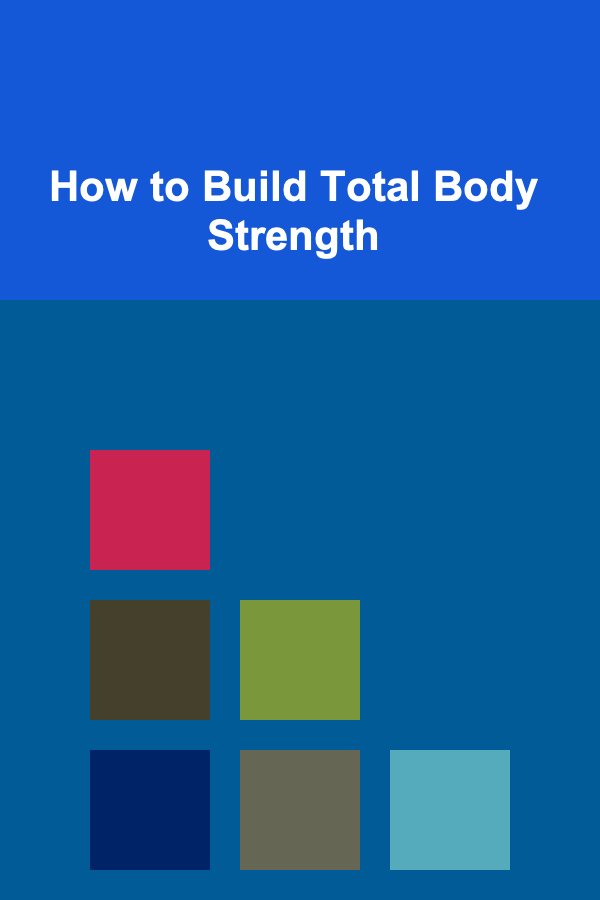
How to Build Total Body Strength
ebook include PDF & Audio bundle (Micro Guide)
$12.99$6.99
Limited Time Offer! Order within the next:

Building total body strength is one of the most effective and rewarding fitness goals that can enhance your overall health, performance, and physical resilience. Total body strength involves developing all major muscle groups of the body --- including the legs, core, and upper body --- in a balanced and functional way. Unlike focusing on just one part of the body, training the entire body helps build a more versatile, well-rounded physique and improves your ability to perform everyday activities and sports.
This article explores the fundamental principles, exercises, and strategies for building total body strength, providing both beginners and advanced fitness enthusiasts with the tools they need to enhance their overall fitness.
Understanding Total Body Strength
Total body strength refers to the ability of your body to exert force in various directions, whether it's lifting, pushing, pulling, or holding. It doesn't just mean increasing muscle size but developing the functional capacity of all muscle groups to work together efficiently. Building strength in one area --- for example, your legs --- without developing others, such as your upper body or core, can lead to imbalances and increase the risk of injury.
Strength is typically developed through resistance training, which can include weightlifting, bodyweight exercises, and various resistance tools like resistance bands. It is crucial to focus on both compound exercises (which work multiple muscle groups at once) and accessory exercises (which target specific muscles) to achieve balanced and sustainable strength.
The Importance of Total Body Strength
1. Improved Athletic Performance
For athletes, building total body strength is essential for improving performance across various sports. Whether you play basketball, soccer, or run long distances, the strength gained from total body training enhances endurance, agility, explosiveness, and overall functional capacity.
2. Injury Prevention
A well-developed body with balanced strength helps protect against injuries by ensuring that all muscle groups are strong enough to support one another. For instance, a strong core helps protect the lower back, while balanced leg and upper body strength can reduce the risk of joint injuries.
3. Functional Fitness
Total body strength directly translates to real-world benefits. Everyday tasks like lifting groceries, carrying children, or even maintaining good posture while sitting or standing become easier when your muscles are strong and work synergistically.
4. Better Posture and Balance
Strengthening the entire body improves posture and balance, which can help alleviate common discomforts like back pain or muscle strain. A strong core is essential for maintaining good posture, while leg strength helps with stability and preventing falls.
5. Enhanced Metabolism and Fat Loss
Total body strength training can lead to increased muscle mass, which in turn boosts metabolism. As muscle burns more calories than fat, incorporating full-body exercises into your routine can support long-term fat loss and promote better body composition.
Principles of Building Total Body Strength
1. Progressive Overload
Progressive overload is the principle of gradually increasing the intensity of your workouts to challenge your muscles and force them to adapt. This can be done by increasing the weight you lift, the number of sets or repetitions you perform, or the frequency of your workouts. Progressive overload ensures continual muscle growth and strength improvement.
2. Variety in Training
Incorporating a variety of exercises into your routine helps target different muscle groups from various angles and prevents plateaus. It also reduces the risk of overuse injuries, as you're not repeatedly stressing the same muscle fibers in the same way.
3. Rest and Recovery
Rest and recovery are crucial elements of any strength-building program. Overtraining can lead to injury or burnout, while adequate rest allows muscles to repair and grow stronger. Ensure you get sufficient sleep and allow 48 hours between working the same muscle group to allow for full recovery.
4. Balance Between Compound and Isolation Exercises
While compound exercises should form the core of your total body strength routine, accessory isolation exercises help fine-tune individual muscles and address weaknesses or imbalances.
5. Consistency
Like any fitness goal, building total body strength requires consistency. Committing to regular workouts and focusing on both strength and form will yield the best long-term results. Aim for at least 3-4 strength training sessions per week, incorporating a mix of compound and isolation exercises.
Key Exercises for Total Body Strength
1. Squat
The squat is a foundational compound movement that targets the quadriceps, hamstrings, glutes, and lower back. It's an excellent exercise for building lower body strength and improving mobility.
How to Perform:
- Stand with feet shoulder-width apart, toes slightly turned out.
- Lower your body by bending at the hips and knees, keeping your chest lifted and back straight.
- Squat down until your thighs are parallel to the floor or deeper, ensuring your knees track over your toes.
- Push through your heels to return to the starting position.
2. Deadlift
The deadlift is a full-body exercise that works the hamstrings, glutes, lower back, core, and upper body. It's a powerful movement for building posterior chain strength, which is essential for posture and functional movements.
How to Perform:
- Stand with feet hip-width apart, barbell over the middle of your feet.
- Bend at your hips and knees to grip the bar with your hands just outside your legs.
- Keep your back flat and chest up as you lift the bar, driving through your heels.
- Stand tall at the top, then lower the bar back to the ground with control.
3. Push-Ups
Push-ups are a bodyweight exercise that primarily targets the chest, shoulders, and triceps. They also engage the core and lower body to maintain stability during the movement.
How to Perform:
- Start in a high plank position, with your hands directly beneath your shoulders and your body in a straight line.
- Lower your body by bending your elbows until your chest nearly touches the floor.
- Push through your palms to return to the starting position.
4. Pull-Ups
Pull-ups are one of the best exercises for building upper body strength, targeting the back, biceps, and shoulders. They also help develop grip strength, which is essential for various lifts and tasks.
How to Perform:
- Grab a pull-up bar with your palms facing away from you (pronated grip) or towards you (supinated grip).
- Hang with your arms fully extended, then pull your body upward until your chin is above the bar.
- Lower your body back to the starting position with control.
5. Lunges
Lunges are an excellent exercise for targeting the legs, glutes, and core. They also improve balance and coordination by requiring each leg to work independently.
How to Perform:
- Stand with feet together, then take a large step forward with one leg.
- Lower your hips until both knees are bent at about 90 degrees, keeping your chest lifted.
- Push through the front heel to return to the starting position.
- Repeat on the opposite leg.
6. Plank
The plank is one of the best core-strengthening exercises. It targets the entire core, including the abdominals, obliques, and lower back.
How to Perform:
- Start in a forearm plank position, with your elbows directly beneath your shoulders and your body in a straight line.
- Engage your core, glutes, and legs to maintain the position.
- Hold for as long as you can, aiming to increase your time as your strength improves.
7. Overhead Press
The overhead press is a compound exercise that targets the shoulders, triceps, and upper chest. It also requires core stability to maintain proper form throughout the movement.
How to Perform:
- Stand with feet shoulder-width apart, holding a barbell or dumbbells at shoulder height.
- Press the weight overhead until your arms are fully extended.
- Lower the weight back to the starting position with control.
8. Bent-Over Row
The bent-over row works the back, biceps, and forearms. It's an essential exercise for developing upper body pulling strength and improving posture.
How to Perform:
- Stand with feet shoulder-width apart and bend at the hips, keeping your back flat.
- Hold a barbell or dumbbells with your arms fully extended.
- Row the weight toward your torso, squeezing your shoulder blades together at the top.
- Lower the weight back to the starting position.
Creating a Total Body Strength Program
Beginner's Routine
For beginners, it's important to focus on mastering form and technique before increasing the intensity. A sample beginner's workout might include:
- Squats: 3 sets of 12 reps
- Push-ups: 3 sets of 8-10 reps
- Deadlifts: 3 sets of 8 reps
- Plank: 3 sets, holding for 30 seconds
- Bent-over rows: 3 sets of 10 reps
Intermediate Routine
As you progress, you can increase the volume and intensity of your workouts. An intermediate routine might look like:
- Squats: 4 sets of 8-10 reps
- Deadlifts: 4 sets of 6-8 reps
- Push-ups: 4 sets of 12-15 reps
- Pull-ups: 3 sets of 6-8 reps
- Plank: 3 sets, holding for 60 seconds
- Overhead press: 3 sets of 10 reps
Advanced Routine
For advanced lifters, the focus is on building maximum strength and muscle mass. An advanced routine might involve:
- Squats: 5 sets of 5 reps
- Deadlifts: 5 sets of 5 reps
- Pull-ups: 4 sets to failure
- Push-ups: 4 sets of 20 reps
- Plank: 4 sets, holding for 90 seconds
- Bent-over rows: 4 sets of 6-8 reps
Nutrition and Recovery
To build strength, your muscles need adequate fuel and rest. Proper nutrition is essential to provide the body with the nutrients it needs to repair and grow stronger. Focus on a balanced diet that includes:
- Protein: Essential for muscle repair and growth. Include lean meats, fish, eggs, legumes, and dairy products in your diet.
- Carbohydrates: Provide energy for intense workouts. Whole grains, fruits, and vegetables should be included in your meals.
- Fats: Healthy fats support hormone production, which is essential for muscle growth and recovery.
- Hydration: Staying hydrated is crucial for maintaining performance and recovery. Drink plenty of water throughout the day.
In addition to nutrition, adequate sleep and rest are crucial for recovery. Aim for 7-9 hours of sleep each night and avoid overtraining to allow your muscles to recover and grow.
Conclusion
Building total body strength is a gradual process that requires consistency, dedication, and a well-rounded approach. By incorporating compound exercises, focusing on progressive overload, and paying attention to recovery and nutrition, you can develop a balanced and strong body capable of handling any physical challenge. Whether you're looking to improve athletic performance, prevent injuries, or simply feel stronger in your daily life, building total body strength is one of the most effective and rewarding goals you can pursue.
Reading More From Our Other Websites
- [Home Lighting 101] How to Light a Home Gym for Optimal Performance and Safety
- [Home Pet Care 101] How to Use Crate Training for Dogs: A Beginner's Guide
- [Personal Care Tips 101] How to Apply Mascara Like a Pro in 5 Easy Steps
- [Home Storage Solution 101] How to Optimize Your Bedroom for Better Storage Solutions
- [Screen Printing Tip 101] Profit Margins Unveiled: How to Price Your Screen-Printed Products for Maximum Revenue
- [Organization Tip 101] How to Create a Stylish Yet Functional Closet
- [Organization Tip 101] What Are the Best Ways to Preserve and Organize Old Photos?
- [Personal Care Tips 101] How to Add Body to Fine Hair Without Weighing It Down
- [Survival Kit 101] How to Curate a Luxury Survival Kit for High‑End Glamping Experiences
- [Home Rental Property 101] How to Prepare Your House to Let for New Tenants

How to Build a Content Calendar for Your Dropshipping Store's Marketing Campaign
Read More
How to Use Social Media to Amplify Your Content Strategy
Read More
How To Use Yoga for Weight Management
Read More
How to Design Socks and Underwear for Print-on-Demand
Read More10 Tips for Tracking Rollovers and Transfers in Retirement Accounts
Read More
How to Photograph Street Art Legally
Read MoreOther Products

How to Build a Content Calendar for Your Dropshipping Store's Marketing Campaign
Read More
How to Use Social Media to Amplify Your Content Strategy
Read More
How To Use Yoga for Weight Management
Read More
How to Design Socks and Underwear for Print-on-Demand
Read More10 Tips for Tracking Rollovers and Transfers in Retirement Accounts
Read More